Luteolin suppresses UVB-induced photoageing by targeting JNK1 and p90 RSK2
- PMID: 23551430
- PMCID: PMC3822820
- DOI: 10.1111/jcmm.12050
Luteolin suppresses UVB-induced photoageing by targeting JNK1 and p90 RSK2
Abstract
Multiple lines of evidence suggest that natural compounds can prevent skin ageing induced by ultraviolet light. Luteolin, a bioactive compound found in chilli, onion, broccoli, celery and carrot, has been reported to exhibit anti-photoageing effects in vitro. However, the molecular targets and mechanisms of luteolin are still poorly understood. In this study, we sought to investigate the effects of luteolin on UVB-induced photoageing and the molecular mechanisms involved, using HaCaT human keratinocytes and SKH-1 hairless mice. Luteolin was found to inhibit UVB-induced MMP-1 expression in HaCaT cells, as well as UVB-induced activation of AP-1, a well-known transcription factor targeting the MMP-1 promoter region, as well as c-Fos and c-Jun, which comprise the AP-1 complex. In contrast, Western blot data showed that UVB-induced phosphorylation of JNK, ERK and p90RSK was not inhibited by luteolin. In vitro kinase assay data revealed that luteolin significantly suppressed JNK1 and p90RSK activity, but not that of JNK2 and ERK2. Pull-down assays showed that luteolin binds JNK1 in an ATP-competitive manner and p90RSK2 in an ATP-independent manner. Luteolin also inhibited UVB-induced wrinkle formation and MMP-13 expression, a rodent interstitial collagenase in mouse skin, in vivo. Taken together, our observations suggest that luteolin exhibits anti-photoageing effects in vitro and in vivo and may have potential as a treatment for the prevention of skin ageing.
© 2013 The Authors. Published by Foundation for Cellular and Molecular Medicine/Blackwell Publishing Ltd.
Figures
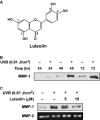
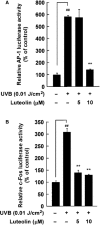
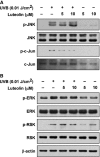
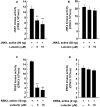
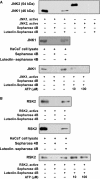
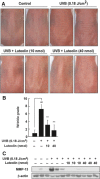

Similar articles
-
Naringenin targets ERK2 and suppresses UVB-induced photoaging.J Cell Mol Med. 2016 May;20(5):909-19. doi: 10.1111/jcmm.12780. Epub 2016 Feb 10. J Cell Mol Med. 2016. PMID: 26861188 Free PMC article.
-
Luteolin inhibits protein kinase C(epsilon) and c-Src activities and UVB-induced skin cancer.Cancer Res. 2010 Mar 15;70(6):2415-23. doi: 10.1158/0008-5472.CAN-09-4093. Epub 2010 Mar 9. Cancer Res. 2010. PMID: 20215519
-
UVB-irradiated human keratinocytes and interleukin-1alpha indirectly increase MAP kinase/AP-1 activation and MMP-1 production in UVA-irradiated dermal fibroblasts.Chin Med J (Engl). 2006 May 20;119(10):827-31. Chin Med J (Engl). 2006. PMID: 16732985
-
MLK3 is a novel target of dehydroglyasperin D for the reduction in UVB-induced COX-2 expression in vitro and in vivo.J Cell Mol Med. 2015 Jan;19(1):135-42. doi: 10.1111/jcmm.12311. Epub 2014 Aug 30. J Cell Mol Med. 2015. PMID: 25176057 Free PMC article.
-
Luteolin as a modulator of skin aging and inflammation.Biofactors. 2021 Mar;47(2):170-180. doi: 10.1002/biof.1699. Epub 2020 Dec 25. Biofactors. 2021. PMID: 33368702 Review.
Cited by
-
Natural drugs targeting inflammation pathways can be used to treat atherosclerosis.Front Pharmacol. 2022 Nov 1;13:998944. doi: 10.3389/fphar.2022.998944. eCollection 2022. Front Pharmacol. 2022. PMID: 36386165 Free PMC article. Review.
-
Luteolin Prevents UVB-Induced Skin Photoaging Damage by Modulating SIRT3/ROS/MAPK Signaling: An in vitro and in vivo Studies.Front Pharmacol. 2021 Aug 30;12:728261. doi: 10.3389/fphar.2021.728261. eCollection 2021. Front Pharmacol. 2021. PMID: 34526903 Free PMC article.
-
Exploring the efficacy and molecular mechanism of Danhong injection comprehensively in the treatment of idiopathic pulmonary fibrosis by combining meta-analysis, network pharmacology, and molecular docking methods.Medicine (Baltimore). 2024 May 10;103(19):e38133. doi: 10.1097/MD.0000000000038133. Medicine (Baltimore). 2024. PMID: 38728523 Free PMC article.
-
Plant-Derived Natural Products in Cancer Research: Extraction, Mechanism of Action, and Drug Formulation.Molecules. 2020 Nov 14;25(22):5319. doi: 10.3390/molecules25225319. Molecules. 2020. PMID: 33202681 Free PMC article. Review.
-
Mechanisms Underlying the Therapeutic Effects of Brucea javanica in Cervical Cancer Treatment Based on Network Pharmacology and Molecular Docking.Int J Genomics. 2025 May 30;2025:9956789. doi: 10.1155/ijog/9956789. eCollection 2025. Int J Genomics. 2025. PMID: 40487864 Free PMC article.
References
-
- Fisher GJ, Kang S, Varani J, et al. Mechanisms of photoaging and chronological skin aging. Arch Derm. 2002;138:1462–70. - PubMed
-
- Fisher GJ, Datta SC, Talwar HS, et al. Molecular basis of sun-induced premature skin ageing and retinoid antagonism. Nature. 1996;379:335–9. - PubMed
-
- Gilchrest BA, Park HY, Eller MS, et al. Mechanisms of ultraviolet light-induced pigmentation. Photochem Photobiol. 1996;63:1–10. - PubMed
-
- Fisher GJ, Wang ZQ, Datta SC, et al. Pathophysiology of premature skin aging induced by ultraviolet light. New Engl J Med. 1997;337:1419–28. - PubMed
-
- Beissert S, Schwarz T. Mechanisms involved in ultraviolet light-induced immunosuppression. J Investig Dermatol Symp Proc. 1999;4:61–4. - PubMed
Publication types
MeSH terms
Substances
LinkOut - more resources
Full Text Sources
Other Literature Sources
Medical
Research Materials
Miscellaneous

